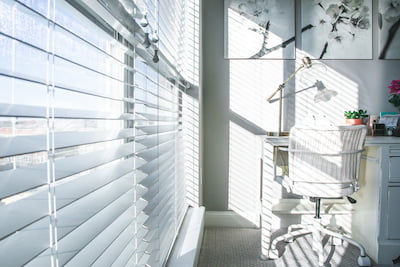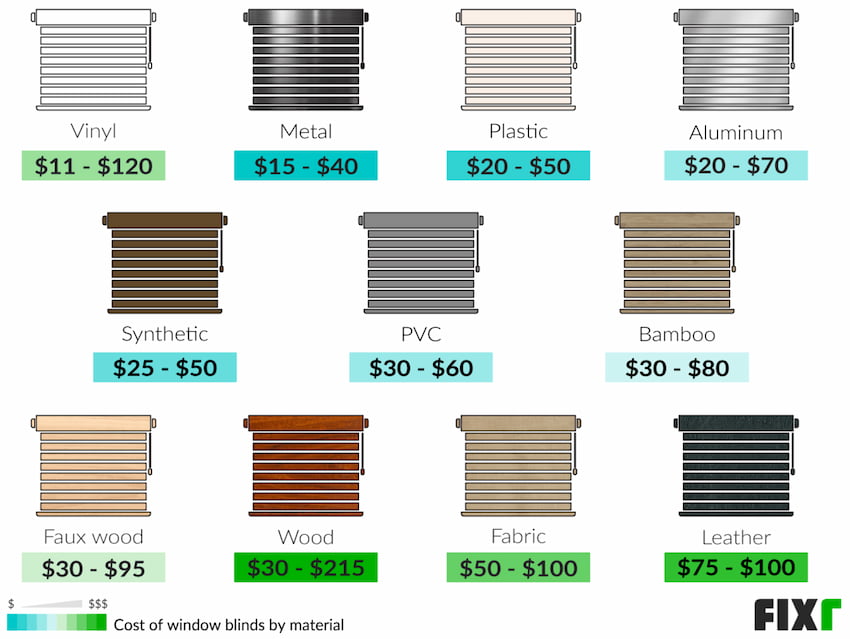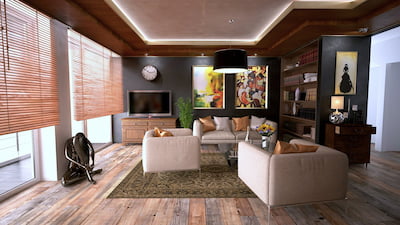What Are the Best Materials for Window Blinds?
 Window blinds are wonderful to help tie together a room. Though they are often overlooked when initially moving in, window blinds are essential for maintaining a comfortable environment throughout your home.
Window blinds are wonderful to help tie together a room. Though they are often overlooked when initially moving in, window blinds are essential for maintaining a comfortable environment throughout your home.
These fixtures ensure proper privacy in windowed areas, and they make it easier to control how much light shines into the room. They are easy to clean and maintain, and with proper dusting, they'll look great for years to come. In this article, we will weigh the ups and downs of the variety of materials used for window blinds.
Window blinds are often made out of vinyl, metal, synthetic, faux wood, and natural wood. Each of these materials can offer great form and function, but let’s discuss which one might be right for your home. We will break them down by affordability, maintenance, durability, and style.

Vinyl
Let’s start with one of the most popular options, vinyl. With the housing market ramping up production of new builds, vinyl quickly became a popular option because of the cost. For each window, you can expect vinyl blinds to cost $11 to $120.
Vinyl blinds in mass-produced homes are often white and plain in design. However, many designs and colors are available for customization. They require very little maintenance, but the expected lifespan of these blinds is much shorter than other options.
Vinyl can sometimes get bent and broken with extensive use, but the price point and style still make them worth the expense for many homeowners.
Metal
This next option combines affordability and durability. The price per window for metal blinds falls between $15 and $40, and they are much more durable than vinyl. With proper maintenance and care, a set of metal blinds can last a lifetime. However, these are not as customizable as vinyl.
This type of blind is lightweight and extremely durable. There is no need to worry about rust formation because metal blinds are often made of corrosion-resistant alloys rather than irons that rust when exposed to moisture. This option is great for long term use.
Synthetic
Synthetic blinds are a fantastic alternative to those made of expensive materials. The price point on these ranges from $25 to $50. Synthetic materials come in many different patterns and styles and can imitate costly materials like cedar or bamboo. They are built to last, so this option blends durability with the style you want.
Most synthetics are built as a cheaper alternative to materials like wood, but they are also designed to be more durable than fragile plastics. In this category, you might find options like PVC and vinyl, but various types of faux woods are the most common.
Faux Wood
Faux wood is a blend of materials that work to mimic the look and feel of wood. These blinds are built to be durable, and they are much more affordable than real wood. The price point on faux wood blinds will rest somewhere between $30 and $95 per window.
The material used to replicate the look of wood can include virtually anything durable such as PVC, vinyl, composite, and foam wood. Each of these materials is more affordable and can match the durability of natural woods. They probably won’t last quite as long as natural woods, but they are more durable than other synthetic options like vinyl and plastic. It’s a little more expensive, but the durability and style make faux woods popular.
Natural Wood
Wooden blinds are usually made of natural hardwoods that are sophisticated and durable. Faux wood might mimic the look, but natural woods give an unmatched sense of style and warmth to the room. These are very durable and won’t bend or bow with repetitive use like plastics, vinyl, and faux wood.
Though these are a favorite of most interior decorators, the cost will be significantly higher than most materials. The price can range from $30 to $215, so these are not made for a budget build design.

When to Use Each Material
It can be a little overwhelming to find the right materials if you’re unfamiliar with their uses. Let’s look at when certain materials should and should not be used.
Natural Wood vs. Faux Wood
If you want a wood look but you’re afraid to shell out the extra money, faux wood will most likely suit your needs. However, if you’re looking for something durable and long-lasting, natural woods will not bow and break as easily as synthetic materials.
Pay attention to your environment before deciding which material is right for you. Humid climates will shorten the lifespan of natural woods, so a faux wood or metal fixture may be better for your needs in this case.
Horizontal blinds can be made of heavier materials because they are designed to be stationary and only move up or down. Virtually any material can be used for these, but remember the length, width, and panel size will drastically affect the cost. A large panel blind made of natural wood can run over $200 per window.
If it’s within budget, natural woods are a wonderful material for window blinds. They can provide a rustic elegance that can’t quite be accomplished with faux wood. However, faux wood will get you closer to that look if natural woods are outside of your price range.
Other Synthetics, Vinyl, and Metals
Also, consider the type and style of blinds that fit your home design. Many blinds are styled horizontally, like paneled blinds, Venetian blinds, and micro blinds. These blinds require different materials than something like a vertical blind.
Vertical blinds require a more lightweight design because they are made to dangle over the window. They only move side to side, so you will not be able to pull them above the window. Wood may not be a good idea for this type of blinds because they can bounce freely against the window and cause damage. This type of blind works best with lightweight materials such as synthetics and vinyl.
Metals can also be a great addition here for a more rustic or industrial appeal. Synthetics can provide virtually any type of style to your décor if you’re going for a more modern look, but metal is much more durable in the case of vertical blinds. Overall, the materials needed for vertical blinds are usually much more affordable, but they can wear out much sooner than horizontal blinds.
Before deciding on a set material, consider what design best fits your needs and use recommended materials for that design. Take stock of your current environment and weigh this with your budget before your initial purchase and installation.

In Summary
Window blinds are an affordable customization option that can easily elevate a room’s décor. Many people think of thin white plastic when blinds come to mind, but multiple materials are now available to restyle any home.
Overall, there are good and bad things about each material, and hopefully, you’ve learned which option best suits your needs. Any of these can be a great addition to your windows. Find a material and design that makes your space feel like home!



.png)
.png)
 Window blinds are wonderful to help tie together a room. Though they are often overlooked when initially moving in, window blinds are essential for maintaining a comfortable environment throughout your home.
Window blinds are wonderful to help tie together a room. Though they are often overlooked when initially moving in, window blinds are essential for maintaining a comfortable environment throughout your home.



